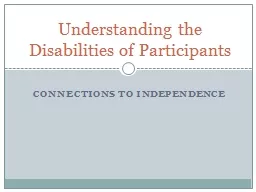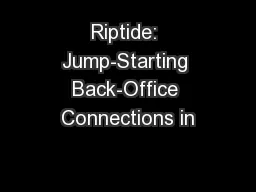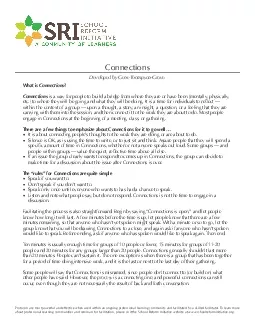PPT-Connections to independence
Author : mitsue-stanley | Published Date : 2018-10-21
Understanding the Disabilities of Participants Objective This presentation is designed to give you an overview of many different disabilities you may encounter
Presentation Embed Code
Download Presentation
Download Presentation The PPT/PDF document "Connections to independence" is the property of its rightful owner. Permission is granted to download and print the materials on this website for personal, non-commercial use only, and to display it on your personal computer provided you do not modify the materials and that you retain all copyright notices contained in the materials. By downloading content from our website, you accept the terms of this agreement.
Connections to independence: Transcript
Understanding the Disabilities of Participants Objective This presentation is designed to give you an overview of many different disabilities you may encounter during your contact with consumers It is not meant to be an indepth look at various disabilities Disabilities included in this presentation are. 4.2 - Ideas Help Start a Revolution. 4.2 – Ideas Help Start a Revolution. Main Idea. Essential Question. What is the difference between declaring independence and being independent?. Objectives. The Debate Begins. A Few of Notes. Declaration of Independence. July 4, 1776. Adopted by the Continental Congress of the 13 American Colonies. The main purpose was to explain and give reasons why the American colonists were revolting against the British Empire. Overall Unit. I. . Age of the Articles of Confederation (1776-1789). II. Age of Federalism (1789-1800). III. Jefferson, the Era of Good Feeling, and the Embargo(1800-1809). Revolution. I. Revolution (looking ahead). Think, pair and share!. What did you learn about annotating last session?. Spend . 1 minute thinking . and writing, spend . 2 minutes sharing. with the person sitting next to you and . 2 minutes sharing with the class . Click on the target to begin. Review (Principles of Democracy). Principle of Democracy. Example. -People. have rights that cannot be taken away by government. -All people are equal. -People vote/make decisions in government. 2. 3. Forces On Structures. Forces from gravity, wind, and seismic events are imposed on all structures. Forces that act vertically are gravity loads. Forces that act horizontally, such as stability, wind and seismic events (the focus of this discussion) require lateral load resisting systems to be built into structures . What were the arguments for and against colonial independence from Great Britain?. 11.1 Introduction. Patriots. Did not want Great Britain to rule. Some argued in speeches and newspapers. Some joined mobs. 1791-1845. Independence Movements in Latin America. European domination of Latin . America. Spread . of Enlightenment . ideas. American . and French . revolutions. Growth . of nationalism in Latin America. Visitor & Member Follow-Up. Yvonne Gentile and Melanie Hill. Online Resources: . li.cor.org/workshops. Effective Visitor Follow-up. Prompt. Personal. Pleasant. Source: Bill . Easum. (2007) – . Terminology. Tories: Loyalists. Whigs: . Patriots. Neutral: not taking sides. Pacifism: belief that no one should fight or resort to violence for any reason other than defense. What was the Proclamation of 1763?. Cloud Systems. Flores, . Khakpour. , . Bedi, et al. Presentation by cameron cunning. What is the problem?. In large-scale cloud networks, communication between datacenters results in a significant performance cost. install. guide. Roberto Boccadoro – ELD . Engineering. Martti. Garden - IBM. What is IBM Connections Docs ?. With IBM Docs, teams can simultaneously collaborate on word processing, spreadsheet and presentation documents inside and outside the firewall to improve productivity. . Matthew Wicks. Director of School Accountability. Pearson Online & Blended Learning. Image placeholder. Connections Academy Online Schools. Connections Academy virtual schools provide a . full-time online education to students in grades K-12. Developed by Gene Thompson-GroveWhat is ConnectionsConnections is a way for people to build a bridge from where they are or have been mentally physically within the context of a group upon a thought
Download Document
Here is the link to download the presentation.
"Connections to independence"The content belongs to its owner. You may download and print it for personal use, without modification, and keep all copyright notices. By downloading, you agree to these terms.
Related Documents














